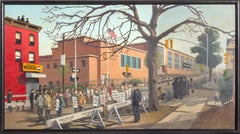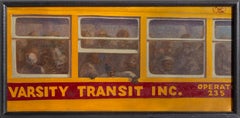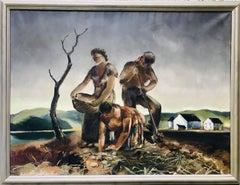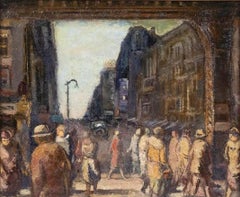William Waithe Figurative Paintings
to
1
1
Overall Width
to
Overall Height
to
2
1
2
1
1
1
1
1
2
2
4
467
321
258
227
2
2
Artist: William Waithe
Teacher's Strike, Oil Painting by William Waithe
By William Waithe
Located in Long Island City, NY
This painting by William Waithe depicts a teachers strike, possibly the infamous teachers' strike in 1970 by Newark teachers which at the time was the longest teachers' strike in the...
Category
1970s American Realist William Waithe Figurative Paintings
Materials
Oil
Varsity Transit Inc., Realist Oil Painting by William Waithe
By William Waithe
Located in Long Island City, NY
Born in Harlem, William Waithe studied painting, drafting and architecture at New York University and Queens College. He was known for painting outdoors, and is particularly identifi...
Category
Late 20th Century American Realist William Waithe Figurative Paintings
Materials
Oil
Related Items
“New Americans" 1941 WPA Exhibited Carnegie Percy Albee
Located in Exton, PA
Monumental, important WPA painting signed by Percy Albee. The painting is oil canvas measuring 36" x 48". Titled verso "New Americans", this WPA painting was exhibited at the Carnegi...
Category
1940s American Realist William Waithe Figurative Paintings
Materials
Oil
$6,000
H 40 in W 52 in D 2 in
Columbus Avenue NYC c. 1920s/30s American Scene Ashcan WPA Modern 20th Century
By Bernard Gussow
Located in New York, NY
Columbus Avenue NYC c. 1920s/30s American Scene Ashcan WPA Modern 20th Century
"Late Afternoon, Columbus Avenue, New York", impasto oil on canvas, signed lower left, signed verso (under relining, shown in photo), and titled verso on stretcher, in maple mitered cove frame, 23 1/4" x 27 1/4", SS: 19 1/4" x 23 1/4", Relined.
BIO
Russian-born Gussow trained at the Art Students League and the National Academy of Design. He also studied under Bonnat at the Ecole des Beaux-Arts in Paris. His first claim to fame was exhibiting two works at the Armory Show in 1913. Gussow exhibited at the Society of Independent Artists between 1917 and 1934 and at Salons of America in the 1930s.
The Whitney Museum of American Art, for example, has his Subway Stairs. The Barnes Foundation...
Category
1920s American Realist William Waithe Figurative Paintings
Materials
Canvas, Oil
"Bustling Alley at Dusk" Oil Painting
By Christopher Clark
Located in Denver, CO
Christopher Clark's (US based) "Bustling Alley at Dusk" is an original, handmade oil painting that depicts a dreamy cityscape that features turn of the century buildings lining an alley where throngs of people gather at cafes and walk past in the light of the setting sun.
Bio/artist statement:
Christopher has been an artist since early childhood, when he would watch Bob Ross on PBS and mimic the famed oil painter’s art with crayons. He considers himself a self-educated artist, with his studies ranging from personal training with contemporary masters, to classical academic art technique, with much inspiration from 19th Century art and the Impressionist Movement. Christopher lived in Italy for a time, immersing himself in Italian culture and art, which continues to influence his painting. His fan base has grown considerably since his return to the US, gaining the attention of Lucasfilm and Marvel Fine Art, which both signed him as an officially licensed artist in 2016. Other clients include George Lucas, Major League Baseball, Louisville Slugger, and Fender Guitars.
Christopher’s painting skills are not his only talent in the arts. He has won several national swing dance championship competitions, and also studies tango and blues dancing. He has played guitar since the age of 12, and during his time as lead guitarist for a rock band, he opened for Blue Oyster Cult...
Category
2010s American Realist William Waithe Figurative Paintings
Materials
Oil, Wood Panel
Snow in the City, American Winter Scene Painting, Ornate Frame, Mid-Century Oil
Located in Marco Island, FL
American life is captured in this Clyde Singer painting, Snow in the City (1954), where he depicts an everyday moment in the city. An ordinary scene, of a group of women making thei...
Category
1950s American Realist William Waithe Figurative Paintings
Materials
Oil, Board
$50,000
H 41 in W 36 in D 4 in
Puddle Jumper. Woman With Umbrella Original Oil American Rainy Scene Painting.
Located in Marco Island, FL
An ordinary scene of a woman walking down a sidewalk in the rain is elevated to a little gem of a painting. American life is captured in this Clyde Singer painting, Puddle Jumper (...
Category
Late 20th Century American Realist William Waithe Figurative Paintings
Materials
Canvas, Oil
$3,500
H 15.5 in W 13.5 in
"Snowy City Scene" American Scene Social Realism WPA Era Mid-20th Century Modern
Located in New York, NY
"Snowy City Scene" American Scene Social Realism WPA Era Mid-20th Century Modern
Syd J. Browne (1907-1991)
"Snowy City Scene"
22 x 30 inches
Oil on canvas. c. 1930s
Signed lower lef...
Category
1930s American Realist William Waithe Figurative Paintings
Materials
Canvas, Oil
Calder Sculpture in Lincoln Center- New York City American Scene Painting
Located in Marco Island, FL
Clyde Singer was a master at capturing the moments, small and significant in everyday American life. This painting, "Calder Sculpture in Lincoln Center", is a glimpse of an ordinar...
Category
1970s American Realist William Waithe Figurative Paintings
Materials
Oil, Canvas
$14,000
H 34 in W 35 in D 2 in
Women's City Club, Youngstown, Ohio. American Historical Scene Painting.
Located in Marco Island, FL
An accomplished American Scene painter, Clyde Singer successfully captured everyday life during his long career. A unique aspect of American life is depicted in this painting, entitl...
Category
1940s American Realist William Waithe Figurative Paintings
Materials
Oil, Board
$32,000
H 19 in W 27 in D 3 in
Bathers 1940s Mid 20th Century American Scene Social Realism WPA Modern Ashcan
Located in New York, NY
Bathers 1940s Mid 20th Century American Scene Social Realism WPA Modern Ashcan
Marion Gilmore (1909-1984)
Bathers
15 1/2 x 19 1/2 inches
oil on canvas boar...
Category
1940s American Realist William Waithe Figurative Paintings
Materials
Oil, Board
Brooklyn Bridge NYC American Scene Social Realism Mid 20th Century Modern WPA
By Cecil Crosley Bell
Located in New York, NY
Brooklyn Bridge NYC American Scene Social Realism Mid 20th Century Modern WPA
Cecil C. Bell (American, 1906-1970)
Brookyn Bridge amid the NYC Waterfront
35 ½ x 23 ½ inches
Oil on Bo...
Category
1930s American Realist William Waithe Figurative Paintings
Materials
Oil, Board
$25,000
H 39 in W 27 in D 2 in
City Peril. Mid-Century American Urban Scene Oil Painting of Crime.
Located in Marco Island, FL
The danger of American life is captured in this Clyde Singer painting, City Peril (1958), where he depicts a moment in the city where a woman is targeted while walking. An accomplish...
Category
1950s American Realist William Waithe Figurative Paintings
Materials
Oil, Board
$14,000
H 15.5 in W 13.5 in
London Round House-Mid-Century Industrial American Scene Oil Painting
By Jack Steele
Located in Marco Island, FL
A mid-century American Realist scene of children playing on the railroad entitled, London Round House. The chaotic scene of children rambunctiously playing is suspected to be set in...
Category
1940s American Realist William Waithe Figurative Paintings
Materials
Canvas, Oil
$14,000
H 52 in W 43 in D 3 in
William Waithe figurative paintings for sale on 1stDibs.
Find a wide variety of authentic William Waithe figurative paintings available for sale on 1stDibs. You can also browse by medium to find art by William Waithe in oil paint, paint and more. Not every interior allows for large William Waithe figurative paintings, so small editions measuring 32 inches across are available. Customers who are interested in this artist might also find the work of Gordon Brown, Mark Harrison, and Carl Bretzke. William Waithe figurative paintings prices can differ depending upon medium, time period and other attributes. On 1stDibs, the price for these items starts at $3,000 and tops out at $6,000, while the average work can sell for $4,500.



